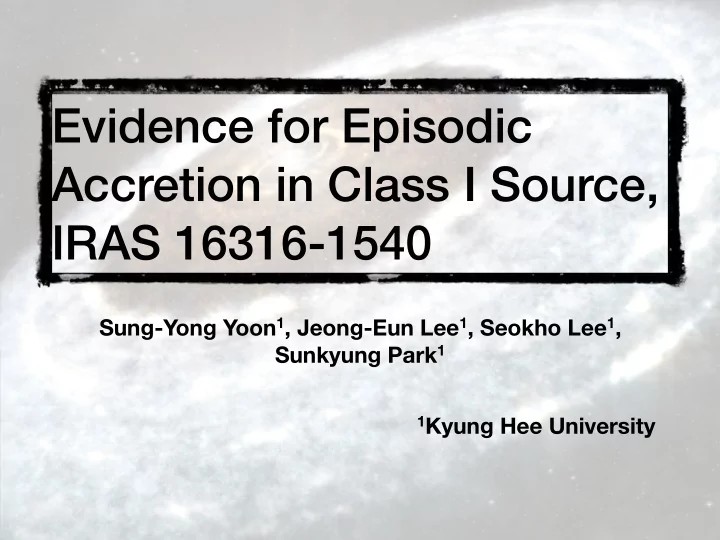

Evidence for Episodic Accretion in Class I Source, IRAS 16316-1540 Sung-Yong Yoon 1 , Jeong-Eun Lee 1 , Seokho Lee 1 , Sunkyung Park 1 1 Kyung Hee University
Contents 1.Introduction 1.1. Inner Region of Protoplanetary Disk 1.2. IGRINS Survey of Protoplanetary Disks 1.3. Characteristics of FU Orionis-type objects 2. Results 2.1. Spectra of Class I Objects 2.2. Class I & FU Ori-type Objects 2.3. Cross-correlation of IRAS 16316-1540 with FUors and Class I Sources 3.Analysis 3.1. Stellar Rotation vs. Disk Rotation 3.1.1. Standard Stars 3.1.2. Veiling 3.1.3. Chi-square test 3.2. Results of the Disk Rotation and Stellar Rotation 4.Summary & Future work
1. Introduction
1.1. Inner Region of Protoplanetary disk Dullemond et al. (2010)
1.2. IGRINS Survey of Protoplanetary Disks A part of Korea IGRINS Legacy program (PI : Jeong-Eun Lee). Spectroscopic observation of inner gaseous disks provides useful information about the formation process of star and planet, through line features that depend on accretion, wind, and rotation as well as timescale of gas dissipation and planet formation. The survey covers wide ranges of age, luminosity, and mass (from Class I to WTTS, and from low mass to Herbig Ae/Be and massive YSOs) It also covers FU Orionis-type objects (FUors) in which an outburst occurs.
1.2. IGRINS Survey of Protoplanetary Disks Type Total Observed Remained 3 MYSOs 4 1 8 Herbig Ae/Be 10 2 10 Class I 10 0 17 CTTS (Class II) 18 1 9 WTTS (Class III) 10 1 8 FUors 8 0 55 Total 60 5
1.2. IGRINS Survey of Protoplanetary Disks Type Total Observed Remained 3 MYSOs 4 1 8 Herbig Ae/Be 10 2 10 Class I 10 0 17 CTTS (Class II) 18 1 9 WTTS (Class III) 10 1 8 FUors 8 0 55 Total 60 5
1.3. Characteristics of FU Orionis- type objects Large, sudden increases of brightness( ≳ 4 mag) called outburst occur in the optical- wavelengths region in Classical T Tauri stars. The outbursts of FUors are believed as a result of enhanced accretion rate in circumstellar disk. “Double-peaked” or “boxy” absorption line profiles produced by Keplerian rotation of the disk. The varying spectral types with wavelengths; optical and infrared spectra are consistent with F-G (T eff ~ 7200-6500 K) and K-M supergiant (T eff ~ 3000-2000 K), respectively. Hartmann & Kenyon (1996)
1.3. Characteristics of FU Orionis- type objects Large, sudden increases of brightness( ≳ 4 mag) called outburst occur in the optical- wavelengths region in Classical T Tauri stars. The outbursts of FUors are believed as a result of enhanced accretion rate in circumstellar disk. Hartmann et al. (2016) “Double-peaked” or “boxy” absorption line profiles produced by Keplerian rotation of the disk. The varying spectral types with wavelengths; optical and infrared spectra are consistent with F-G (T eff ~ 7200-6500 K) and K-M supergiant (T eff ~ 3000-2000 K), respectively. Hartmann & Kenyon (1996)
2. Results
2.1. Spectra of Class I objects
2.2. Class I & FU Ori-type objects
2.3. Cross-correlation of IRAS 16316-1540 with FUors and Class I sources Type Name Correlation r-value 0.74 FUors 2MASS J06593158-0405277 10.769 0.735 FUors HBC 722 12.031 0.709 FUors FU Ori 10.892 0.428 Class I IRAS 18341-0113(N) 9.948 0.372 Class I IRAS 03301+3111 5.845
3. Analysis
3.1. Disk Rotation vs. Stellar Rotation Stellar Rotation Disk Rotation
2.1.1. Standard Stars We take the standard stars from IGRINS spectral library (Park et al. 2017, submitted). 87 standard stars Spectral type : G0 ~ M7 Luminosity Class : I ~ V
Infalling gas on magnetic field 2.1.2. Veiling Hot spot Continuum excess of the disk weaken the depth of the absorption lines. It is called ‘veiling’. It is defined as the ratio of the intrinsic equivalent width (EW) to observed EW. EW i = (1 + r k )EW o Circumstellar disk
2.1.3. Chi-square test Select a stellar template Convolution with the disk/stellar rotation profile of v sin i Interpolation Cross correlation r k : veiling factor M : standard star T : IRAS 16316-1540 X 2 = Σ {( r k M - T) 2 / σ 2 } ∂ X 2 / ∂ r k = 0 Comparison of the X 2 values of entire stellar template Estimation of the spectral type of IRAS 16316-1540
3.2. Results of the Disk Rotation and Stellar Rotation K5V HD36003 2.1358 Si I 2.2088 Na I 2.2812 Mg I 1.00 Relative Flux 0.98 0.96 Disk rotation Stellar rotation 0.94 − 200 − 100 0 100 200 − 100 0 100 − 200 − 100 0 100 200 - 1 ) Velocity (km s Best fit result Spectral type : K5 V Disk (stellar) rotation velocity : ~ 40 km s -1 (~60 km s -1 ) Veiling (r k ) : ~ 1
4. Summary & Future work The episodic accretion makes the broadened absorption lines with boxy or double-peaked profile which is produced by Keplerian disk. We found that the spectrum of Class I source, IRAS 16316-1540, shows broad absorption features similar to those of FUors. We could fit the broad absorption features of IRAS 16316-1540 with the K5 V template spectrum convolved with the disk rotation profile of about 40 km -1 . s It suggests that the episodic accretion can occur from the early stage of star formation and detect its signature using high-resolution spectrograph, IGRINS. We will study protoplanetary disks observed with IGRINS using statistical analysis to explore physical and chemical structure of the inner region of the disk.
Recommend
More recommend